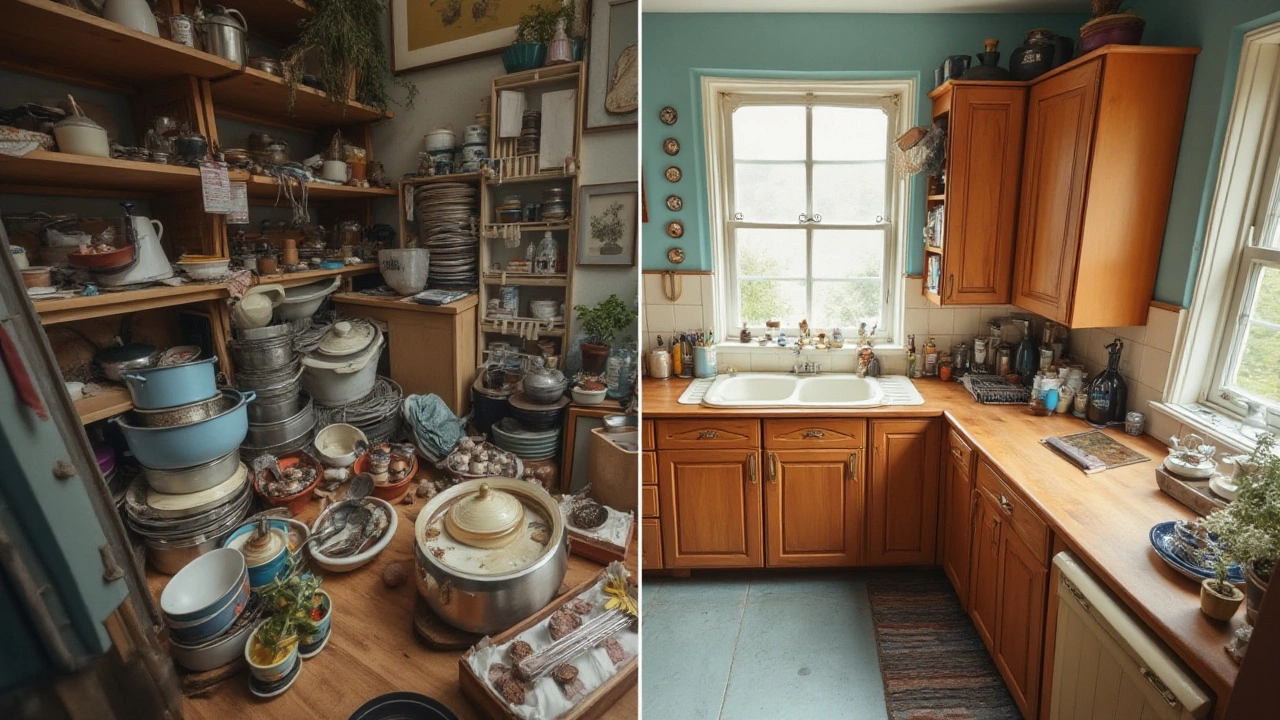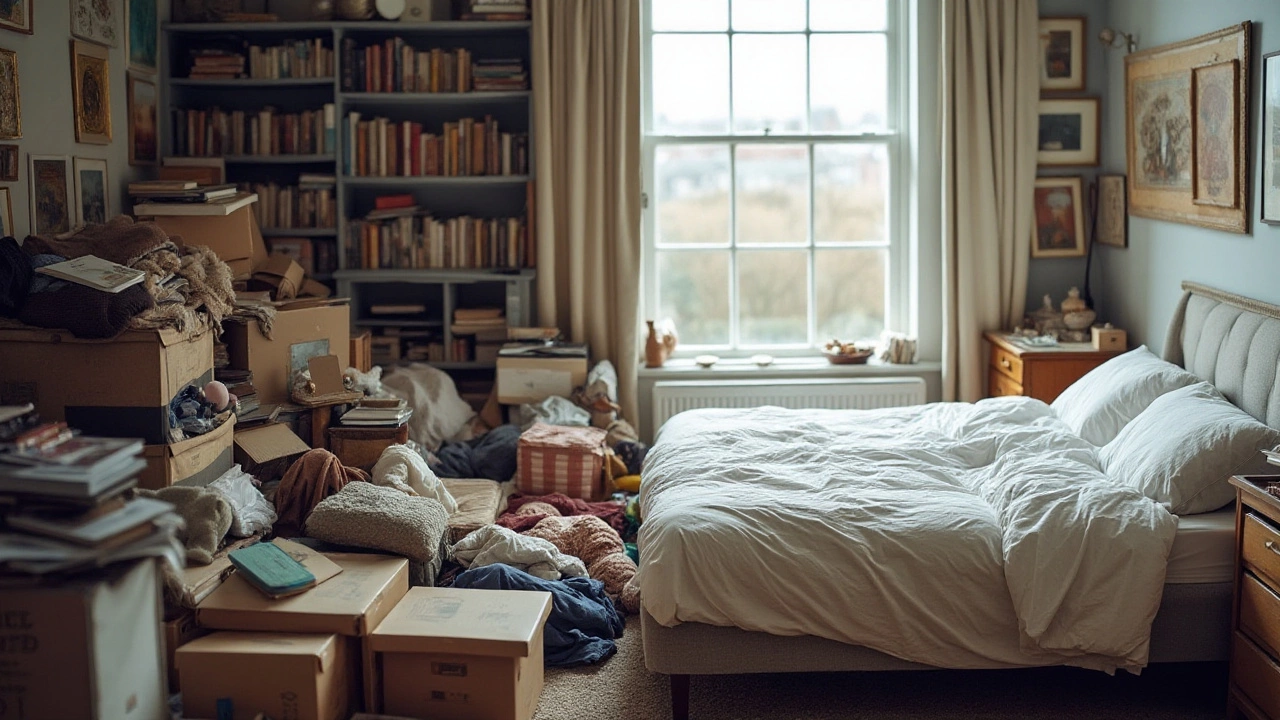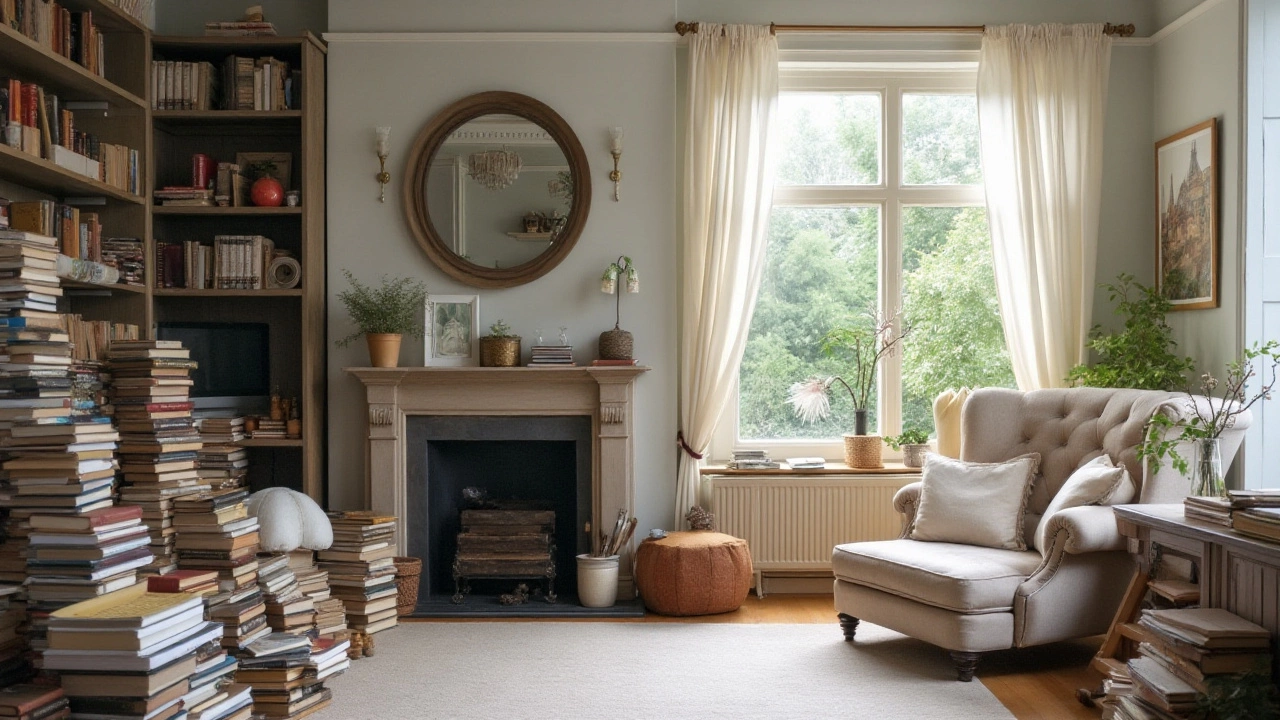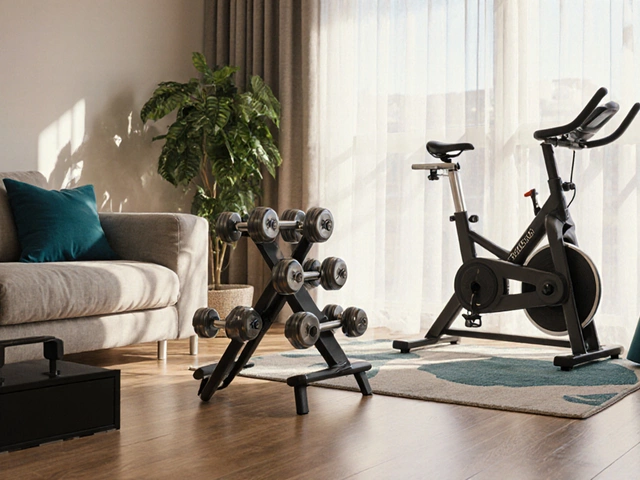Decluttering a home often feels like an intimidating task, but it becomes manageable when you know where to start. The first rule of decluttering—a crucial guiding principle—can make all the difference as you embark on this organizational journey. It's not just about tossing aside items blindly; it's a thoughtful practice that helps to create a functional and peaceful living space.
This foundational concept is rooted in reflection and decision-making, where you consciously assess what you truly need and cherish in your life. By focusing on what sparks joy and serves purpose, you can begin to sort through possessions with a clear goal in mind. This is more than a cleaning exercise; it is an opportunity to evaluate what you want your home to represent and how it can better serve your everyday living.
- The Essence of the First Rule
- Psychological Benefits of Decluttering
- Practical Tips for Getting Started
- Room-by-Room Declutter Strategies
- Maintaining a Clutter-Free Home
- Embracing Minimalism as a Lifestyle Choice
The Essence of the First Rule
At the heart of effective decluttering lies a rule that is as simple as it is profound: start by deciding what to keep, not what to discard. This rule turns the usual method of clearing out our living spaces on its head and is often cited as the cornerstone of successful home organization. Traditionally, people approach decluttering by selecting items to throw away, which can be overwhelming and lead to decision fatigue. By shifting the mindset to focus on what adds true value, every decision made during the decluttering process becomes anchored in positivity and intent.
The concept of keeping what 'sparks joy' was popularized by Marie Kondo, a pioneer in the decluttering movement. She emphasizes the emotional aspect of each item, encouraging individuals to connect deeply with their belongings. Her approach resonates with many who view decluttering as a personal journey rather than just a chore. This transformative rule is not just about making space but about curating a collection of possessions that genuinely reflect who you are and how you wish to live.
"The question of what you want to own is actually the question of how you want to live your life." – Marie Kondo
Scientifically, living in a clutter-free environment has been shown to reduce stress and increase productivity. A 2011 study published in 'The Journal of Neuroscience' revealed that excess items in the environment could negatively impact one's ability to focus. By applying the first rule, individuals can systematically reduce clutter and create an organized, serene living space that enhances their mental wellbeing. The benefits of a tidy home are not just limited to improved focus but extend to enhancing daily routines and overall quality of life.
Decluttering techniques also align with the principles of minimalism, advocating for intentional living and conscious consumption. This rule is not only applicable during major cleanouts but also serves as an enduring practice—guiding decisions about new acquisitions and ensuring that each item brought into the home adds value. It fosters a thoughtful relationship with your surroundings, encouraging minimal yet meaningful living. By applying this guiding principle consistently, you can create a home environment that is both practical and joyful, devoid of excess that distracts from life's more important experiences.
It's important to remember, the first rule is not about achieving perfection or creating an aesthetic that pleases others. It is deeply personal and introspective, allowing you to define what 'home' means to you. As you begin to sort through items, ask yourself: Does this item enhance my life? Is it useful, or does it bring me happiness? Let these questions drive your decisions and watch how your space transforms into a sanctuary that resonates with intentionality and purpose—a true reflection of your values and lifestyle choices.
To put this rule into practice, start with a small space—a drawer or a single shelf. Assess each item, and be mindful of your emotional response to it. Analyze its function, beauty, and significance in your life. By honing these decision-making skills in manageable areas, the task of decluttering larger spaces becomes less daunting. This deliberate approach not only leads to a more organized home but also instills a sense of accomplishment and discipline, shaping habits that yield long-term benefits in every aspect of life.
Psychological Benefits of Decluttering
Decluttering is not just a physical activity but a profound mental exercise. People often underestimate the significant psychological benefits that come with a tidy and organized environment. Imagine the relief you feel when you walk into a clean, clear space after a long day at work. This isn't merely a fleeting sense of calm; studies suggest that organized environments can significantly reduce anxiety and stress. A study published in the Personality and Social Psychology Bulletin found that individuals who described their homes as cluttered were more likely to report high levels of fatigue and depression. On the other hand, those who perceive their homes as restful and restorative experience a sense of psychological well-being. The act of organizing your space helps declutter the mind as well, promoting clarity and enabling deeper focus on tasks at hand.
It's fascinating how our surrounding environment influences our mental state. Excessive clutter can cause sensory overload, which ultimately leads to feelings of being overwhelmed. When too many items occupy your visual space, it becomes difficult for your brain to process or prioritize information effectively. By reducing clutter, you allow your brain to process information clearly and efficiently. A tidied space offers a sense of accomplishment and control, impacting not just your mental health but increasing productivity and creativity. Freeing up your mental bandwidth results in more energy to focus on goals, be it at work or in personal life. This efficiency often leads to achieving tasks with greater ease, feeding into an ongoing cycle of positivity and achievement.
For many, decluttering can also serve as a form of therapy. The process of sorting through belongings allows a person to engage in introspection and make decisions about their life and values. It becomes an opportunity to let go of items that might hold emotional baggage, offering closure and relief. Additionally, dedicating time to declutter can be a meditative activity, focusing your mind and allowing worries to fade into the background. There's a rewarding aspect of physically seeing your progress, which boosts your mood and inspires continued decluttering efforts.
Moreover, there's a communal and familial aspect to consider. Families often find that organizing their spaces together builds bonds and encourages shared responsibility. When everyone contributes to a clutter-free environment, it fosters open communication and healthier family dynamics. Children who are involved in maintaining home organization learn valuable life skills and develop a sense of responsibility. Through the act of decluttering, one not only crafts a home that nurtures but also cultivates a harmonious atmosphere where each member feels valued and less stressed.
Reflecting on the myriad benefits of decluttering, it becomes evident that keeping a tidy space leads to a more present-focused life. It allows you to direct energy towards building memories and experiences within a space that nurtures rather than restricts. As author and tidying expert Marie Kondo famously said, "The objective of cleaning is not just to clean, but to feel happiness living within that environment." This sentiment captures the transformative power of decluttering, urging us to create spaces that align with our emotional and mental well-being.

Practical Tips for Getting Started
Taking the first step toward a more organized home begins with setting clear intentions and breaking down the process into manageable actions. One effective approach is to start small, selecting one area or type of item, to avoid feeling overwhelmed. Begin by dedicating a specific amount of time each day to decluttering, which not only builds momentum but also makes the task seem less daunting. Remember, it's important to not rush the process, as the key is to make thoughtful decisions about what stays and what goes.
Creating a plan can significantly improve your decluttering success. Identify specific goals for each space in your home, considering how you want each room to function and feel. For instance, if your kitchen is cluttered, focus on clearing counters and organizing cabinets to enhance both efficiency and aesthetic appeal. Don’t forget about storage logistics; knowing where cleaned items will reside is crucial to maintaining a tidy living space. To achieve home organization effectively, enlist the help of storage solutions like baskets, bins, or drawer dividers to keep everything in its rightful place.
Many people find it beneficial to use a decision-making framework, such as the KonMari Method, which advocates for keeping items that spark joy. This can be a helpful guideline, especially for sentimental pieces, though some prefer more practical criteria, like the six-month rule—only keeping what you've used in the last six months. When more motivation is needed, consider the advice of Marie Kondo herself, who reminds, "The best way to find out what we really need is to get rid of what we don’t."
It's also advantageous to prepare for the emotional aspect of decluttering, as parting with items can sometimes be challenging. Start by acknowledging and understanding the feelings attached to certain belongings. Develop strategies to cope with such feelings, whether by photographing items for memories before letting them go or envisioning their newfound utility for someone else. This approach often instills a sense of satisfaction, knowing you're contributing to a cycle of reuse when you donate or sell items you no longer need.
To keep track of your progress, maintain a checklist of completed areas, which can serve as a visual motivator as you see your accomplishments grow. Consider setting up a reward system for yourself, such as celebrating small victories with a treat or doing something enjoyable after a declutter session. These actions reinforce the positive experiences associated with decluttering, turning it into an ongoing practice rather than a one-off task.
Finally, involve others in your household to ensure home organization becomes a shared effort, which not only fosters a sense of teamwork but also makes it more likely to adhere to new habits. Communication is vital; discuss expectations and schedules to minimize frustrations and build a collective commitment to maintaining a clutter-free environment. With these decluttering tips, you can embark on a rewarding journey toward a tidier, more serene home, where each object serves a purpose and every space radiates tranquility.
Room-by-Room Declutter Strategies
When tackling clutter, approaching it on a room-by-room basis allows for more focused and achievable progress. Every room in the house serves different functions and contains unique items, so it's essential to adapt your decluttering tips to fit these specific contexts. Start with one of the most frequently-used areas: the kitchen. This bustling hub attracts gadgets, utensils, and items that often go unused. Begin by emptying out drawers and cupboards, assessing each piece based on frequency of use and condition. Remember the ‘use it or lose it’ principle, which helps in letting go of duplicates or out-of-date pantry items.
In the living room, a space for relaxation and socializing, aim to create a welcoming ambiance by clearing away excess decor and furniture. Examine your collection of books, magazines, and entertainment devices to ensure they serve your present lifestyle. Consider digitizing media to save space, while being intentional about decorative elements that reflect your style without overwhelming the senses. Bedrooms can quickly become repositories for items beyond their intended purpose. In this private sanctuary, clothing, accessories, and neglected hobbies often accumulate. Marie Kondo, the famed organization consultant, suggests asking, “Does this spark joy?” while decluttering your closet. This question can be pivotal in deciding what stays and what goes, enabling a tailor-made minimalistic experience.
In children's rooms, decluttering requires practicality paired with an understanding of sentimentality. Embrace strategies like the one-in, one-out rule to maintain balance as toys and clothes continue to enter the space. Smart storage solutions, such as labeled bins and under-bed organizers, make it easier for kids to participate in cleaning tasks. Bathrooms, usually smaller, can be swiftly decluttered by discarding expired products and unused toiletries. Keep surfaces clear by storing essentials in baskets and behind cabinet doors to maximize storage without cluttering counter space.
“Clutter is not just the stuff on the floor, it’s anything that stands between you and the life you want to be living,” says Peter Walsh, a professional organizer.
Finally, for the garage or basement, areas notorious for clutter, label boxes and sections to manage long-term storage efficiently. Setting up specific zones for tools, sports gear, or seasonal decorations allows for easy access. Consider donating items that have spent over a year untouched. Staying organized in these spaces can significantly enhance the practicality and enjoyment of your home. In embracing these room-by-room strategies, you're paving a path toward a minimalism that aligns with both functionality and your personal definition of comfort.

Maintaining a Clutter-Free Home
Keeping a home clutter-free isn't just about a one-time clean-up; it involves creating habits and systems that support an organized lifestyle. To maintain decluttering achievements, it's essential to adopt ongoing strategies that prevent the reaccumulation of unnecessary items. Regular review sessions, much like spring cleaning but more frequently, can help you stay on top of what enters and leaves your living space. These periods of reflection and action allow you to assess whether new purchases or gifts serve a purpose without adding to the chaos.
An effective method to sustain a clutter-free home is the one-in, one-out rule. For every new item that you bring into your home, make a conscious decision to let go of something old. This practice not only controls the quantity of objects but also encourages mindful consumption. It ties into the core idea of minimalism, where the focus is on ensuring that each item has a place and a purpose.
Home organization experts often suggest having designated storage spaces for various categories of items. Labeling boxes, shelves, and bins can significantly improve accessibility and accountability. When everything has its designated spot, it becomes easier to notice when something is out of place or when an area needs tidying up. A systematic approach like this reduces mental clutter and anxiety about cleaning.
Additionally, fostering a clutter-free lifestyle involves establishing and reinforcing daily habits. Activities such as making the bed, washing dishes promptly, and setting aside time each day to tidy up minor messes make tidiness a routine part of life rather than a periodic chore. These small acts build up and maintain larger, sustained efforts to keep a home organized.
It's worth noting a perspective shared by Marie Kondo, author of "The Life-Changing Magic of Tidying Up." She emphasizes,
"The question of what you want to own is actually the question of how you want to live your life."This statement highlights the link between the physical space around us and our personal well-being and life choices. Acknowledging this connection can motivate ongoing commitment to living clutter-free.
An interesting statistic to consider is that the average American home today contains over 300,000 items. Despite this abundance, studies have shown that we regularly use only about 20% of what we own. Recognizing this discrepancy can serve as a powerful incentive to minimize and control clutter proactively. One proven way to reduce this overabundance is to implement a systematic donation schedule, where once every few months, you go through your belongings and donate what you haven't used in a year.
Creating a Decluttering Schedule
Consistency in home organization can be supported by setting aside specific times for minor and major tidying tasks. Perhaps dedicate one weekend day each month to a specific area—like the kitchen or garage—to re-evaluate and reorganize as needed. This approach divides the larger goal into manageable segments, reinforcing the habit and ensuring it doesn't become overwhelming.Embracing Minimalism as a Lifestyle Choice
Minimalism isn't just an aesthetic; it's a way of life that encourages mindful consumption and intentional living. Many people find themselves overwhelmed by the constant accumulation of things, often leading to stress and discontentment. By adopting minimalist principles, individuals can focus on what truly matters, creating space for experiences, relationships, and personal growth. A minimalist lifestyle does not mean living with nothing but rather living with intention, where every item has a purpose and adds value to your life. Through minimalism, one learns to appreciate quality over quantity and to find satisfaction in simplicity and sustainability.
Minimalism started gaining traction as a response to consumer culture, offering an alternative that shifts focus from material possessions to life-enhancing experiences. Research suggests that people who embrace minimalism report higher levels of happiness and lower stress levels. Minimalism speaks to the human desire for clarity and simplicity in an increasingly complex world. As you declutter your physical environment, you also make mental space, leading to improved concentration and creativity. By dedicating time and effort to intentionally choosing what you own, you can build an environment that supports your goals and values.
Adopting a minimalist lifestyle involves more than just purging your closet or downsizing possessions; it is about redefining priorities and aligning actions with values. This transition may take time and conscious effort, but the rewards are substantial. You'll find that the benefits of living a simplified life ripple into various aspects, from financial stability to personal relationships. Emphasizing the importance of less can guide you toward a serene and purposeful life. A minimalist home fosters a sense of tranquility, providing a sanctuary that nurtures well-being and creativity.
For those new to minimalism, understanding the philosophy behind it is crucial. Consider asking yourself questions like, "Does this item serve a practical function or bring joy?" and "Am I holding onto this out of necessity or habit?" such introspection can help you make deliberate decisions that align with a minimalist ethos. As Leo Babauta, author of Zen Habits, poignantly notes,
"Minimalism is the intentional promotion of the things we most value and the removal of anything that distracts us from it."This profound insight encapsulates the minimalist mindset, encouraging us to cherish what is meaningful while letting go of what is not.
Minimalism also fosters ecological awareness by promoting conscious consumption and reducing waste. By buying less and choosing durable, sustainable products, those practicing minimalism effectively lessen their environmental footprint. A minimalist lifestyle not only benefits individuals but also contributes positively to the planet. It shifts focus from fleeting trends and possessions to enduring values and experiences. Choosing minimalism can transform everyday interactions, making them more mindful and appreciative of simplicity's beauty. It invites an environment where you are free to be present, seeking joy in less complexity and more meaning.
Implementing minimalism as a lifestyle choice may seem challenging initially, but it's about finding balance and simplicity that works best for you. Here are a few steps to begin this journey:
- Start small by decluttering one area of your home at a time.
- Assess the emotional attachments you have with your belongings.
- Identify your core values and ensure your possessions align with these values.
- Practice gratitude by acknowledging what you have, focusing on the essentials and living intentionally.





